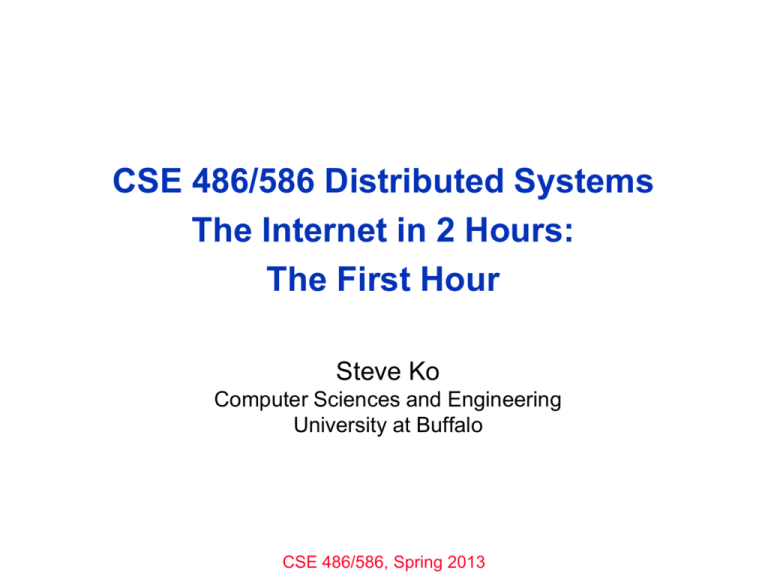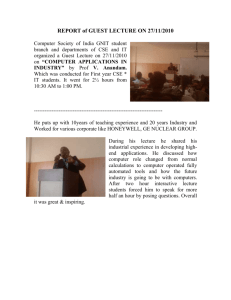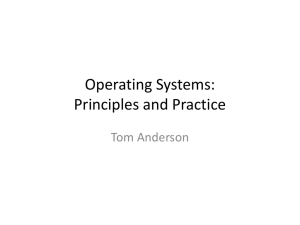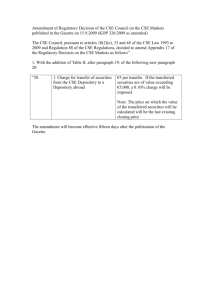pptx - University at Buffalo, Computer Science and Engineering
advertisement

CSE 486/586 Distributed Systems The Internet in 2 Hours: The First Hour Steve Ko Computer Sciences and Engineering University at Buffalo CSE 486/586, Spring 2013 Recap • Please make an effort to come to every class. • Please do the work yourself. • This course: – Introducing common problems that arise when building a distributed system – Discussing algorithms, architectures, and abstractions that solve those problems – Practicing how to adapt those algorithms and concepts CSE 486/586, Spring 2013 2 Today and Next • A brief overview of the Internet • Two things – The design philosophy of the Internet (“The Design Philosophy of the DARPA Internet Protocols” by David Clark): today – Transport & application layers: next lecture • Obviously can’t replace a networking course; please take it if you haven’t---it’s interesting! • Why teach these? – Because I want to ;-) – If there’s no network, there’s no distributed system. – Not just that: the design of the Internet is a great example of designing a solid distributed system. CSE 486/586, Spring 2013 3 What Is the Internet? • 1969 CSE 486/586, Spring 2013 4 What Is the Internet? • 1977 CSE 486/586, Spring 2013 5 What Is the Internet? • Now • A network of networks • The fundamental goal of the original designers: interconnecting different networks by designing common protocols CSE 486/586, Spring 2013 6 Detour: What is a Protocol? • Example: making an appointment Please meet with me forfor Please Pleasemeet meetwith withme me for 1.51.5 hours starting at at 1.5hours hoursstarting starting at 1:30pm on February 8, 2006? 3:00pm 4:30pmon onFebruary February8,8,2006? 2006? I can’t. I can’t. Yes! • Well…I think we need a better way… CSE 486/586, Spring 2013 7 Detour: What Is a Protocol? • Bob: When are you free to meet for 1.5 hours during the next two weeks? • Alice: 10:30am on Feb 8 and 1:15pm on Feb 9. • Bob: Book me for 1.5 hours at 10:30am on Feb 8. • Alice: Yes. CSE 486/586, Spring 2013 8 Detour: What is a Protocol? • An agreement between entities in communication – Two things: 1) syntax, 2) semantics • Syntax – What language? – What’s the time format? Granularity? – Etc. • Semantics – – – – If broken into pieces, how do you reassemble? If a msg gets lost, what do you do? If you get a msg, what do you do? Etc. CSE 486/586, Spring 2013 9 Returning back: What Is the Internet? • A network of networks • The fundamental goal of the original designers: interconnecting different networks by designing common protocols CSE 486/586, Spring 2013 10 CSE 486/586 Administrivia • Recitations will begin from next week. – M (10:00 – 10:50) & F (2:00 – 2:50) @ 106 Baldy • PA 1 description will be out soon. • Please use Piazza; all announcements will go there. – Anonymous/private posting: generally questions are beneficial to the whole class; please consider posting it publicly first. – If you want an invite, let me know. • Please come to my office during the office hours! – Give feedback about the class, ask questions, etc. CSE 486/586, Spring 2013 11 Building the Internet • Why care? – Now: you might be just doing what’s given to you. – Later: you will likely define what you want to do and do it. • Internet as a case study of a distributed system – Put a designer’s hat on for a moment. • Questions to think about: – Why? i.e., why do we want to connect computers? – What is the ideal outcome? i.e., what do we want? – How do we do that? CSE 486/586, Spring 2013 12 Why and What • Why – “The whole can be greater than the sum of its parts” • What – Internet communication must continue despite loss of networks or gateways. – The Internet must support multiple types of communications service. – The Internet architecture must accommodate a variety of networks. – The Internet architecture must permit distributed management of its resources. – The Internet architecture must be cost effective. – The Internet architecture must permit host attachment with a low level of effort. – The resources used in the Internet architecture must be accountable. CSE 486/586, Spring 2013 13 How to Interconnect? • There were many types of networks based on various physical media. – Coax, radio, satellite, etc. • The original designers wanted to interconnect those somehow. • A potential solution – Designing a “multi-media” network (e.g., via physical signal translator for various physical media) • Solution chosen? – Hint: “All problems in computer science can be solved by another level of indirection.” --- David Wheeler – Connecting by layering with packet switching – (We will not cover packet switching vs. circuit switching) CSE 486/586, Spring 2013 14 Layering: A Modular Approach • Sub-divide the problem – Each layer relies on services from layer below – Each layer exports services to layer above • Interface between layers defines interaction – Hides implementation details – Layers can change without disturbing other layers • “The” computer science approach – ISA, OS, networking… Application Application-to-application channels Host-to-host connectivity Link hardware CSE 486/586, Spring 2013 15 Challenges in Layering • What to put on top of physical networks? • Assumption (for the sake of the discussion): – Packet switching (a conversation is divided into smaller units called packets). • Basic things for enabling a conversation between remote hosts: – Addressing (where do I send a msg?) – Routing (how do I reach that address?) • Most importantly, survivability – Protection of a conversation as long as there’s a physical path between entities communicating and they are alive. • What are some of the threats that disrupt a conversation? – Packet loss, out-of-order delivery, duplicate packets, etc. CSE 486/586, Spring 2013 16 Summary • The Internet – A network of networks – A case study as a distributed system • Protocol – An agreement between multiple parties – Syntax & semantics • Design a system – Why, what, and how • The Internet – Connecting by layering CSE 486/586, Spring 2013 17 Acknowledgements • These slides contain material developed and copyrighted by – Indranil Gupta at UIUC – Mike Freedman and Jen Rexford at Princeton CSE 486/586, Spring 2013 18




